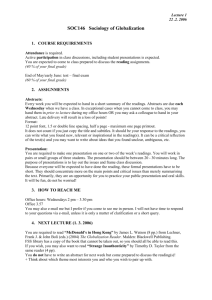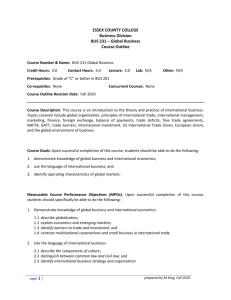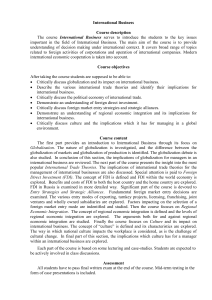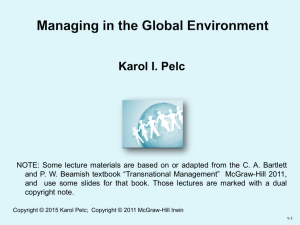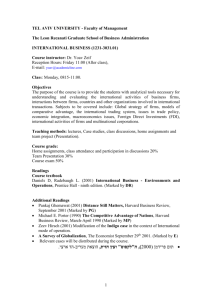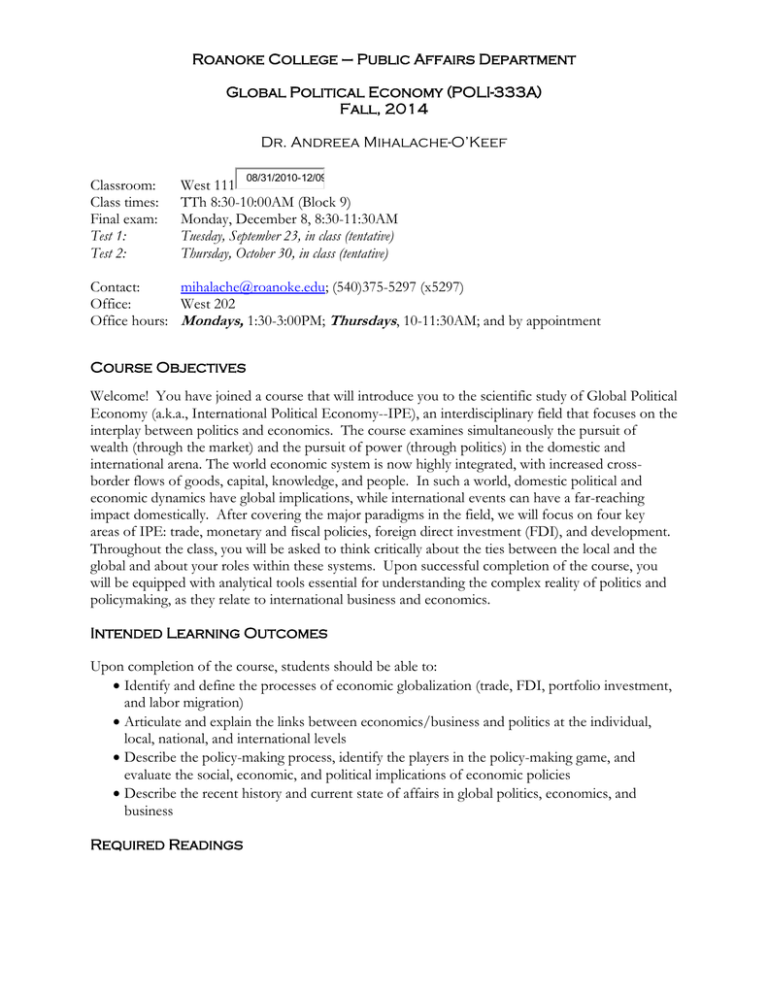
Roanoke College – Public Affairs Department
Global Political Economy (POLI-333A)
Fall, 2014
Dr. Andreea Mihalache-O’Keef
Classroom:
Class times:
Final exam:
Test 1:
Test 2:
08/31/2010-12/09
West 111
TTh 8:30-10:00AM (Block 9)
Monday, December 8, 8:30-11:30AM
Tuesday, September 23, in class (tentative)
Thursday, October 30, in class (tentative)
Contact:
mihalache@roanoke.edu; (540)375-5297 (x5297)
Office:
West 202
Office hours: Mondays, 1:30-3:00PM; Thursdays, 10-11:30AM; and by appointment
Course Objectives
Welcome! You have joined a course that will introduce you to the scientific study of Global Political
Economy (a.k.a., International Political Economy--IPE), an interdisciplinary field that focuses on the
interplay between politics and economics. The course examines simultaneously the pursuit of
wealth (through the market) and the pursuit of power (through politics) in the domestic and
international arena. The world economic system is now highly integrated, with increased crossborder flows of goods, capital, knowledge, and people. In such a world, domestic political and
economic dynamics have global implications, while international events can have a far-reaching
impact domestically. After covering the major paradigms in the field, we will focus on four key
areas of IPE: trade, monetary and fiscal policies, foreign direct investment (FDI), and development.
Throughout the class, you will be asked to think critically about the ties between the local and the
global and about your roles within these systems. Upon successful completion of the course, you
will be equipped with analytical tools essential for understanding the complex reality of politics and
policymaking, as they relate to international business and economics.
Intended Learning Outcomes
Upon completion of the course, students should be able to:
Identify and define the processes of economic globalization (trade, FDI, portfolio investment,
and labor migration)
Articulate and explain the links between economics/business and politics at the individual,
local, national, and international levels
Describe the policy-making process, identify the players in the policy-making game, and
evaluate the social, economic, and political implications of economic policies
Describe the recent history and current state of affairs in global politics, economics, and
business
Required Readings
The required texts are listed below. All the substantive readings for this class will be posted on
Inquire and/or distributed in class at least two days before they are due. These readings ARE
REQUIRED and it is your responsibility to check Inquire often to make sure that you are up to date
with the readings and well prepared for class. If you have any difficulty with the system, ask for help
sooner rather than later! The class is taught under the assumption that you have completed the
reading prior to coming to class.
Scott, Gregory M., and Stephen M. Garrison. 2011. The Political Science Writer’s Manual, 7th ed. New
York, NY: Pearson-Prentice-Hall.1
The New York Times (or other reliable new source), September-December 2014. You are expected to
spend 15-30 minutes catching up with the news daily.
Course Grading
The student’s grade for this course will be determined as follows2:
Component
Test 1
Test 2
Final exam (cumulative)
Research paper
Research prep assignments (two)
Preparedness
Participation
% of Final
Grade
10
15
20
25
10
10
10
Grading scale:
>93.0
>89.8
>86.6
>83.0
>79.8
>76.6
>73.0
>69.8
>66.6
>63.0
>59.8
<=59.8
A
AB+
B
BC+
C
CD+
D
DF
More on the assignments that determine your grade:
1. Tests and final exam
a. The exams will cover both material discussed in class and the required readings. The
final exam is cumulative.
b. Absences from exams without appropriate justification and/or prior permission from
the instructor will result in a grade of 0 (ZERO).
c. Make-up policy: No make-up examination will be given. Book review papers (page
length and content requirements to be determined by the instructor) will be assigned to
make up tests ONLY if (1) the examination was missed due to a medical or family
emergency (further verification - such as a doctor’s note, etc. - may be required) and (2)
the student has obtained prior permission from the instructor to be absent from the
examination.
2. Research paper
a. This exercise is meant to turn you into an expert on an issue within the realm of IPE. It
asks that you assess existing knowledge on your topic, focusing on ongoing debates,
Older editions are acceptable. An online 180 day subscription to this book is available at
http://www.coursesmart.com/9780205830169 . You can also find the book on permanent reserve at Fintel Library, call
number “JA86 .S39 2008.”
2
Other factors may be considered in the case of borderline grades.
1
2
empirical findings, policy relevance, and possibilities for advancing research on that
particular topic. Detailed guidelines for the paper, as well as a list of paper topics, are
included at the end of this Syllabus, in Appendix 1.
b. This 10-page paper is due on Tuesday, December 2, 2014, at the beginning of class.
Papers will not be accepted after 5PM on Monday, December 8. Late penalties apply
(see ‘Late submission of assignments’ at the end of this section).
c. I strongly encourage you to discuss your progress on the paper with me throughout the
semester; the more I know about your successes, challenges, and strategy on the project,
the better I can help you.
3. Research prep assignments
a. To ensure that you are truly developing expertise on your issue, you will complete two
‘Research prep’ exercises, each worth 5% of your overall course grade:
1. Annotated bibliography (Appendix 2 to this Syllabus)
2. Literature synthesis (Appendix 3 to this Syllabus)
4. Preparedness
a. Your preparedness grade will be the average of small exercise grades. Small exercises
may take the form of brief homework assignments, in-class group or individual exercises,
presentations, article critiques, and reading-based quizzes. You can expect about one
exercise every week and occasional reading quizzes at the beginning of class. Each
exercise will be graded out of 10 points. Your overall grade for this component of the
class will be the average of individual exercise grades, dropping the lowest two. Late or
missing write-ups will result in a grade of zero for the day’s exercise. Missed in-class
exercises will also result in a grade of zero. No make-up opportunities will be offered.
5. Participation, which includes
a. Thoughtful, informed, constructive, and articulate participation in class discussion. You
should answer questions, ask questions, pay attention to what others are saying, provide
thoughtful feedback to your peers, etc. Generally, make a point of contributing to class
discussion, when discussion is taking place.
b. Class participation points may be lost in many ways: missing class, being disruptive,
being disrespectful, not paying attention to ongoing class tasks, texting, chatting, surfing
the internet on unrelated topics, being unprepared, repeatedly refusing to answer
questions directed to you etc.
c. You will receive two participation grades during the semester, one at midterm and the
other at the end. Your overall participation grade will be the average of the two.
Grade
Criteria for grading participation
0
Absent or disruptive/disrespectful/frequently unprepared/refuses to participate when called upon.
1
Present, not disruptive.
Tries to respond when called on but does not offer much.
Demonstrates very infrequent involvement in discussion (in class or online).
Demonstrates adequate preparation: knows basics of the readings, but does not show evidence of
trying to interpret or analyze them.
2
3
3
4
Offers straightforward information (e.g., straight from the reading), without elaboration or very
infrequently (perhaps once a class).
Does not offer to contribute to discussion, but contributes to a moderate degree when called on.
Demonstrates sporadic involvement (in class or online).
Demonstrates good preparation: knows reading facts well, has thought through implications.
Offers interpretations and analysis of reading material (more than just facts) to class.
Contributes well to discussion in an ongoing way: responds to other students' points, thinks through
own points, questions others in a constructive way, offers and supports suggestions that may be
counter to the majority opinion.
Demonstrates consistent ongoing involvement (in class or online).
Demonstrates excellent preparation: has analyzed the reading exceptionally well, relating it to the
literature or other material (e.g., other readings, course material, past discussions, experiences,
current events, history etc.).
Offers analysis, synthesis, and evaluation of the reading, e.g., puts together pieces of the discussion
to develop new approaches that take the class further.
Contributes in a very significant way to ongoing discussion: keeps analysis focused, responds very
thoughtfully to other students' comments, contributes to the cooperative argument-building,
suggests alternative ways of approaching material and helps class analyze which approaches are
appropriate, etc.
Demonstrates ongoing very active involvement (in class and online).
Other important considerations that affect your grade:
LATE SUBMISSION OF ASSIGNMENTS:
1. Unless noted otherwise elsewhere in this Syllabus, late assignments are subject to a 7%
penalty for every day past the deadline. Penalties begin accruing 10 minutes after the
deadline is passed (e.g., an assignment due at 2:20PM on a given day is considered late and
loses 7% of the grade at 2:30PM on that day). Outside this 10-minute grade period, no
allowances will be made for technical difficulties. You should consider maintaining
copies of all your files in at least two independent locations.
Course Policies and Performance Standards
Attendance
It goes without saying that in order to perform well in this course you must attend class. Attendance
at all class meetings is required. Absences will have an adverse (negative) impact on overall course
grades. One absence will be permitted; save it for emergencies, athletic competition, and illness. A
second absence and each subsequent absence will result in the lowering of your final grade by one
percent. Chronic absences may result in dismissal from the course with a failing grade. Such
dismissal will be preceded by a formal written warning.
Three other factors will affect your attendance:
1. Being late for class: first time you get a verbal warning; second time, a written warning; any
late arrivals after that will be counted as absences and the policy above will kick in.
2. Not bringing the assigned readings to class: after two verbal warnings, each failure to
bring the readings to class will be counted as an absence and the policy above will kick in.
4
3. Using electronic devices in class when not expressly allowed by the instructor: after
two verbal warnings, each inappropriate use of electronic devices will be counted as an
absence and the policy above will kick in.
Participation
This course relies on student participation in discussing and analyzing course concepts. Active
participation will facilitate the learning process and benefits all parties involved. Through
participation in class discussion and answers to questions when called upon, you can demonstrate
your mastery of the material studied in class and your ability to connect said material to the stories
you have been following in the news. Furthermore, this is a course where collaborative learning is
particularly important. You will learn from me, from publications, but also from your peers. It is
important to be cognizant of all three dimensions of learning and to maximize your benefits from
each by paying attention in class, completing reading assignments, and participating in class
discussion and collaborative exercises when prompted to do so.
Electronic devices
1. Laptops are not to be used in this class, except for occasions where I expressly allow them.
Interaction is important in this class and hiding behind a computer monitor tends to distract
students and lower their performance. All other electronic devices (including - but not limited
to - cell phones, smart phones, tablets, iPads) must be turned off or silenced prior to entering
the classroom.3 It is a simple matter of respect for others.
2. Negative consequences are in order for inappropriate use of electronic devices (see attendance
policy above for details).
3. The use of any electronic device during a test or examination is strictly prohibited, unless
expressly allowed by the instructor. Inappropriate uses of electronic devices during tests or
examinations are considered in violation of academic integrity.
4. Students may not use audio and/or video recording devices in class.
Special academic needs
If you are on record with the Roanoke College Office of Special Services as having special academic
or physical needs requiring accommodations, please discuss this with your instructor immediately.
Accommodations must be discussed before they can be implemented. Also, please note that
arrangements for extended times on exams and testing in a semiprivate setting must be made at least
one week before each exam. If you believe you are eligible for accommodations but have not yet
formally contacted the Office of Special Services, please contact the Center for Learning & Teaching
(x2247).
The Writing Center
The Writing Center @ Roanoke College is located in the Goode-Pasfield Center for Learning
and Teaching in Fintel Library. Student writers working in any field of study at any level of
competence meet with trained peer writing tutors in informal, one-on-one sessions. Writers may
meet with tutors at any point in the writing process, from brainstorming to drafting to editing. Stop
In case of emergencies (anticipating news concerning an ill family member, birth of a family member, etc.), an
exception to this rule may be made through prior consultation with your instructor.
3
5
in or schedule an appointment ahead of time by going to MyRC: Academics and looking for the
Writing Center Schedule link. Email writingcenter@roanoke.edu or call 375-4949 with questions.
Academic integrity
Academic integrity is held in the highest regard at Roanoke College. Academic integrity is expected
and required. Enrollment constitutes acknowledgement by the student of her/his awareness of all
definitions, rules, and procedures relating to academic integrity. Any academic integrity violations
will be dealt with swiftly and severely! Students should read and be aware of the rules and principles
of the College Academic Integrity Handbook. To obtain more information on academic integrity at
Roanoke College, please visit: http://roanoke.edu/AZ_Index/Registrars_Office/Policies_and_Information/Academic_Integrity.htm . If you ever have
any questions concerning Roanoke College’s academic integrity policy, please consult your instructor
immediately.
Tentative Course Plan
IMPORTANT! As the title suggests, this is a TENTATIVE plan. Important dates and
reading assignments may change. For a detailed and up to date schedule of the class, you
MUST consult Inquire. Readings, videos, other assignments required for each class, as well
as important deadlines will be posted online. It is YOUR responsibility to check often and
make sure that you are up to date on your assignments.
Week 1-2: PART 1
Economic Globalization
In this section of the course, we will familiarize ourselves with the concept of
economic globalization, as well as the substantive and methodological bases
of IPE inquiry.
Readings:
The news
Friedman, Chapter 1 in The world is flat
Frankel, “Globalization of the economy”
Frey and Field, “The determinants of infant mortality in less
developed countries”
Other substantive readings will be posted on Inquire.
Week 3-4: PART 2
Perspectives (or theories) of International Political Economy
In this section of the course, we will learn about different perspectives
towards explaining and predicting the outcomes of political competition in a
world with no rules. We will first discuss Realism and Liberalism, the oldest
and still dominant perspectives in International Relations. We will then turn
to some perspectives that challenge the mainstream: Feminism, and Marxism.
Throughout this section of the class we will focus on the theoretical
underpinnings of each of these perspectives, while also applying the
perspectives to current events.
Readings
The news
6
Gilpin, Chapter 1 in Global political economy
Baldwin, “Neorealism, Neoliberalism, and World Politics”
Cardoso, “Dependent development”
Enloe, “Carmen Miranda on my mind”
Hoskins and Rai, 2005, “Gendering IPE”
Mastanduno, “Do relative gains matter?”
Other substantive readings will be posted on Inquire.
TEST 1 will take place in week 5(Tuesday, 9/23/2014).
Week 5-12: PART 3 Globalization processes
In this section of the course we will focus on the processes of economic
globalization. We will talk in some detail about the political and economic
causes of cross-border flows of capital, goods, knowledge, and labor. During
this section of the course, we will also see some examples of economic
models integrated in arguments relating to global politics. There will be a
tiny bit of math involved, but nothing too scary.
Readings
The news
Frieden, “Invested interests”
Dunning, “The eclectic paradigm of international production”
Irwin, “The political economy of free trade”
Other substantive readings will be posted on Inquire.
TEST 2 will take place in week 10 (Thursday, 10/30/2014).
Week 13-15: PART 4 The impact of globalization on human welfare
In this section of the class we will continue to think about the processes of
economic globalization. Instead of looking at the factors that cause (or
influence) these processes, we will begin to evaluate their political, economic,
and social consequences.
Readings
The news
Sen, excerpts from Development as Freedom
Bales, excerpts from Disposable People
Fisman and Miguel, excerpts from Economic Gangsters
Ross, “Oil, Islam, and women”
Samatar, “Structural adjustment as development strategy”
Neumayer and de Soysa, “Trade openness, foreign direct investment,
and child labor”
Other substantive readings will be posted on Inquire.
FINAL EXAM scheduled for Monday, December 8, 8:30-11:30AM
7
Appendix 1: Research paper guidelines (2 pages)
Goal of the assignment:
Present your research in writing, showing that you have good command of the literature on your
topic. Discuss ongoing debates, theoretical knowledge, empirical findings, policy relevance, and
possibilities for advancing research on the topic you studied.
Structure/content requirements:
1. A title page, with:
a. The title of the paper
b. Your name
c. An abstract of the paper
2. Approximately 10-12 pages of text, as follows:
a. Introduction (1-3 pages):
i. State your research question, including explanations of the concepts in your question
(the phenomenon you want to explain and the explanatory concept(s)).
ii. Why is this question interesting? Is it the subject of debate in the literature? Is it
improperly answered in the literature? Is it relevant to the contemporary
political/economic climate? Other reasons? [this section of the paper can draw on
current events and should include facts]
iii. Explain how the paper will proceed (one short paragraph--what are the subsections
of the paper/how is it structured)
b. Literature review including (3-5 pages):
i. Summary/synthesis of the theory and evidence: Describe the knowledge on
your question thus far (summarize/synthesize the existing literature, focusing on
arguments, how the existing arguments relate to each other, predictions, and
evidence. Is there consensus? Is there a debate?)
ii. Critique of the literature Critique the existing literature (Describe some of the
major flaws, gaps, and/or conflicting findings in the literature. Is this a solid
body of literature that you believe provides a convincing and satisfactory answer
to the research question? Or are there certain points of view, arguments,
methodological approaches missing?)
c. Avenues for furthering knowledge on the topic (2-3 pages):
i. Considering what you now know in terms of the research conducted on this
topic, how would you approach it in a future research project? What sort of
questions would you ask? What new theoretical perspective would you bring in?
How would you define/interpret the main concepts? What alternative
explanations would you consider? What approach would you take to providing
empirical evidence? Why do you think your project would be a good
contribution to the literature?
d. Policy relevance (1-3 pages):
i. What are some policy implications/recommendations based on the
literature? In what current/ongoing situations might this research prove useful
and how? Given what you know now on the topic, how comfortable would you
be advising policy-makers? To whom could you make policy recommendations
based on the existing knowledge? What policies would you recommend? Using
evidence from the literature, how would you convince the policy-makers that the
8
particular policy solution you propose works? If you cannot make policy
recommendations, explain why.
e. Conclusion (about 3 paragraphs)
i. Discuss
1. What is known on the topic, based on the literature you studied
2. What real world implications this literature has (what sort of policy
recommendations can be made based on it)
3. What can be done to further knowledge on the topic
3. A works cited page, in the author-date style described in Scott and Garrison.
Other advice:
Remember to cite your sources throughout the paper! Your statements should be backed
with references to the literature. Remember when it is appropriate to use illustrations (i.e.,
anecdotes, testimonials), evidence (i.e., statistics, facts), and support (i.e., scholarly pieces that
advance the same idea, make the same claim, propose the same causal mechanism etc.).
Writing style and mechanics (elegance, clarity, word choice, spelling, sentence structure etc.)
matter (20% of your grade is based on the quality of your writing).
Penalties apply if you do NOT:
o Use headings and subheadings throughout the paper.
o Number your pages.
o Use regular-size font, proper spacing, proper margins etc.
Topic choices for your research paper:
1. What is the effect of political regimes and/or institutions on FDI flows?
2. What is the effect of economic globalization on the environment? (economic globalization:
trade, FDI, or migration) (environment: environmental policy, environmental degradation,
resource extraction, environmental security etc.)
3. What is the effect of foreign aid on foreign investment flows?
4. What is the effect of economic globalization on conflict? (pick: internal, international,
terrorism, ethnic, religious)
5. What is the effect of trade and/or FDI on poverty (i.e., hunger, health, adult and infant
mortality or access to clean water) in the host country?
6. What is the effect of trade and/or FDI on human development (i.e., education, skill levels,
employment) in the host country?
7. What is the effect of economic globalization on women? (women: political equality,
economic equality, political participation etc.)
8. What is the effect of economic globalization on political regimes OR institutions?
9. How do education, income level, and gender affect individual attitudes toward economic
globalization?
For your paper, you will pick one of these questions, but you will have to narrow it down
further. Your question will have the structure, “What is the effect of X on Y?”, and you will
define the X and the Y as narrowly as possible (e.g., ‘ethnic conflict’ instead of ‘conflict’;
‘FDI flows’ instead of ‘economic globalization’ etc.)
9
Appendix 2: Annotated bibliography guidelines (3 pages)
Your bibliography will include at least 15 sources, of which at least 9 must be scholarly (i.e.,
NOT newspaper, magazine, blog, organization website etc.).
List the research question you are studying at the beginning of the document. The bibliography
should have an entry for each relevant article/book you found on your topic for the research
project. Number your entries and organize them as follows: first the academic sources, listed
alphabetically, under the heading “Scholarly sources”; then your other sources, listed alphabetically,
under the heading “Other sources” and indicating next to each source what type it is (opinion
piece, anecdote, popular science etc.)
Scholarly sources: each entry should include:
1. Complete bibliographical citation of the article/book (based on the guidelines in Scott and
Garrison)
2. The research question in the article/book/chapter (what is this study setting out to explain?)
3. The hypothesis in the study (what prediction/conclusion does the study draw?)
4. A SHORT (2-3 sentence) summary of the author’s argument—a description of the causal
mechanism
5. Comments/questions/problems you have with the study or things you particularly like
6. Description of the methodological approach
a. Is it a quantitative or qualitative study?
b. What countries and how many years does the study cover?
Below, I have an example of a bibliographic entry; this is longer than ½ page because there are 3
parts to the argument, 3 hypotheses, etc.
Other sources: each entry should include:
1. Complete bibliographical citation of the article/book (based on the guidelines in Scott and
Garrison)
2. 2-3 sentence summary of what in that source is relevant to your project.
10
Annotated bibliography grading rubric
Content requirements (up to 5.5 points)
1. Student’s research question (or thesis statement) is clearly stated and specific: Yes / No
2. Sources included are relevant to the research question: Yes / Partially / No
a. Relevant sources will:
i. Help define concepts
ii. Describe relationships between concepts
iii. Provide evidence of a certain relationship between concepts
3. Each annotation provides a clear description of the source:
a. Yes / Somewhat / No
4. Each annotation emphasizes component of the source relevant to the student’s paper:
a. Yes / Somewhat / No
5. Each annotation shows critical evaluation of the source (doesn’t stop with summary):
a. Yes / Somewhat / No
Format requirements (up to 1.5 points)
1. Includes student’s research question (or thesis statement): Yes / No
2. Includes 10 sources: Yes / No
a. At least 7 sources are scholarly: Yes / No
3. Entries are numbered: Yes / No
4. Entries are organized in two sections: Yes / No
a. Sections headings follow guidelines: Yes / No
b. Entries are alphabetized (by author’s last name) within each section: Yes / No
c. Entries in “Other sources” indicate type of source, per class handout: Yes / No
5. Citation format follows the author-date bibliographic system (APSA style) described in Scott
and Garrison:
a. Proper punctuation: In all entries / In most entries / No
b. Includes all necessary information: In all entries / In most entries / No
c. Proper order of information: In all entries / In most entries / No
d. Proper indentation: In all entries / In most entries / No
e. Proper capitalization: In all entries / In most entries / No
6. Pages are numbered: Yes / No
7. Student’s name spelled correctly: Yes / No
8. Professor’s name spelled correctly (if included): Yes / No
11
Example of an annotated bibliography entry
Mihalache-O’Keef, Andreea, and Quan Li. 2011. “Modernization vs. Dependency: Effects of FDI on
Food Security in Developing Countries.” International Studies Quarterly 55(1): 71-93.
Research question: How does FDI affect food security in developing countries?
Hypotheses:
1. FDI in mining and agriculture has a negative effect on food security.
2. FDI in manufacturing industries has a positive effect on food security.
3. FDI in the service industries has an indeterminate effect on food security (can’t predict ex-ante
whether it increases or reduces food security)
Summary:
1. FDI in mining and agriculture pays small wages, expropriates small farmers, creates revenue that is
easily captured by the elites reduces food security
2. FDI in manufacturing generally leads to higher wages, technology transfers, training and increases in
skill, lower unemployment increases food security
3. FDI in services is very diverse.
a. Some types of service FDI employ low-skill labor and pay relatively low wages (e.g.,
restaurants, hotels, construction); they also create migration from rural to urban areas and
the farmers who give up their farms to move to the city also give up a secure food supply.
b. Other types of service FDI employ skilled labor and increase wages in the host because the
pool of skilled laborers is limited and, when FDI enters, more employers compete for these
skilled laborers (e.g., medical industry, banking & finance, education)
Comments/questions/problems:
1. If there are several types of service sector FDI, as suggested by the authors’ argument, why did they
not run separate tests for each type of service FDI?
2. Is the effect of agriculture FDI really the same as the effect of mining FDI?
3. Could it be that the effects of FDI are different in democratic vs. authoritarian countries?
Liked:
1. The authors recognize that there is a difference among foreign investors
2. The authors evaluate their hypotheses for all developing countries, so the findings are generalizable;
we can use their results to make predictions about other developing countries in the future.
Methodology:
Quantitative study
Temporal scope: all years between 1980 and 2004; geographical scope: all developing countries for
which the authors could find data
Operationalization:
o FDI = the amount of USD invested by foreign companies in each country, by year
o Food security = annual calorie intake per person, per country
Data sources:
FDI: World Investment Directory published by UNCTAD
Food security: FAOstat published by FAO
12
Appendix 3: Literature synthesis guidelines (1 page)
The write-up for this assignment will address all the points listed below. Use bullet points
whenever possible, rather than writing full paragraphs. This exercise is meant to help you
understand the literature as a whole and synthesize it:
1. In the academic literature you covered for your semester project, is there consensus
(regarding the effect of the explanatory variable on the dependent variable)? If yes,
what is this consensus? If not, what are the predominant points of view and which
authors espouse them? One bullet per point of view.
2. In the literature you studied so far, what are the mechanisms through which the
explanatory variable affects the dependent variable? Cite the author(s) who discuss
each mechanism. One bullet point per mechanism.
3. Evaluate the evidence:
1. what does the evidence say?
2. is it based on single country studies or is it based on samples composed of
multiple countries?
3. what time periods do the authors study?
4. what kind of data do the authors use?
5. what methodology (quantitative or qualitative) do the authors use?
6. based on this evidence, how generalizable are the conclusions?
4. Is there anything missing from this literature?
1. in terms of arguments (do you think the authors are missing any specific
mechanisms? do you think the authors are making unreasonable logical leaps
in their arguments? do you think the authors are completely overlooking an
angle/perspective for analyzing the question? do you think the authors are
overlooking another variable that might influence the relationship?)
2. in terms of evidence (is all the evidence quantitative and based on large
samples? is all the evidence based on qualitative studies of single cases? are
certain regions overlooked? is the temporal span sufficient? do you agree to
the authors' approach to observation (sample, units, indicators etc.)?)
5. Given your answers to question 4 above, how would you approach your own study
of the research question? (from what perspective, what argument, what sort of
evidence?)
6. Include a works cited list. (should be very easy to do based on your Annotated
Bibliography)
Be specific, provide detail, cite as appropriate, be thorough. This should be a detailed
outline of the Literature Review section in your paper.
13




